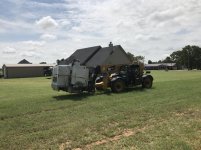I purchased a 1997 model Haas VF0E in 2017 from eBay. My goal is to use it strickly for hobby purposes, namely, for building live steam equipment (see https://ibls.org).
I got a good deal on the machine, and they had a video of it running in production. I am recording my experience here for anyone else it may help.
It became obvious after I received it that it needed some TLC. In addition, it is my first exposure to CNC machining, so I knew I had a learning curve.
My background is in computer programming and hardware development. My only machining experience with machining is as a hobbyist.
So here goes. I plan to add an entry to this thread for each section I've worked on.
I got a good deal on the machine, and they had a video of it running in production. I am recording my experience here for anyone else it may help.
It became obvious after I received it that it needed some TLC. In addition, it is my first exposure to CNC machining, so I knew I had a learning curve.
My background is in computer programming and hardware development. My only machining experience with machining is as a hobbyist.
So here goes. I plan to add an entry to this thread for each section I've worked on.




